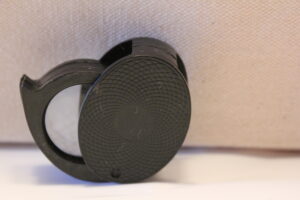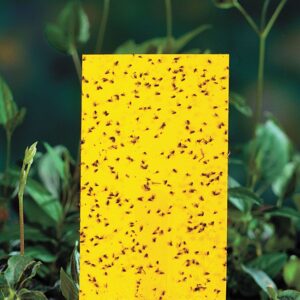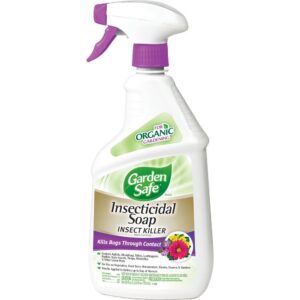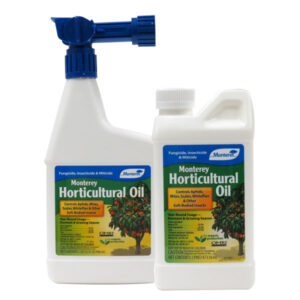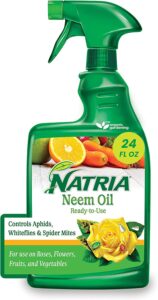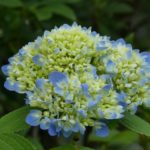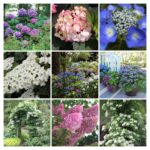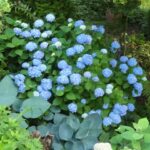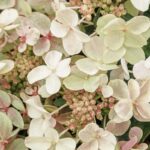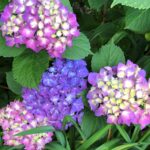Now that our gardening season is finally underway, it’s time to talk about hydrangea insects, what they are and what to do.
Before we get into the discussion of insect management, I must pause to give you my strong position on gardening organically. Here’s where I stand on the use of pesticides and insecticides.
If you have purchased my book, there is an entire chapter devoted to this topic. It might help you to review that for a more in-depth discussion. And remember that my book is now available in electronic format so you can have it at the ready when you are in the garden center or shopping for treatment products.
I encourage you to manage your garden and hydrangeas in accordance with basic principles of Integrated Pest Management (IPM). For our purposes, IPM is defined as an approach of managing pests that considers prevention, avoidance, monitoring, and suppression. When all else fails and you need to intervene by using a pesticide, use one of a biological nature that maximizes safety and reduces risk to the gardener and the environment.
IPM IS YOUR MANTRA
To start with, be aware that only 2 to 3 percent of all insects can actually harm plants. The other 97 percent just fly and crawl around as nature intended. They are part of an ecological system that needs them to exist to keep everything in balance.
With that in mind, I offer my rules of the road as you consider how to treat for insects.
- First rule of IPM is DO NO HARM, i.e., protect beneficials—the good guys in the garden—including ladybeetles, worms, frogs, spiders, and so forth.
- Always know the enemy (life cycle of the insect, how it develops and progresses) before doing anything so you know when to apply treatment for the most effective response.
- Remember that you need to have some bad bugs for the good bugs to eat. If the bad bugs aren’t around, the good bugs fly away. Complete annihilation is not the objective in integrated pest management.
- The first rule translates into a basic philosophy to start with the treatment that has the lowest impact.
- You need to be an observant scout and look for changes in your plants. Inspect the undersides of foliage with a magnifying glass or a hand lens.
Note if there are unusual flying insects and so forth. You want to catch budding problems and address them ASAP.
- GET HELP when you don’t know what’s going on. Your local extension office or a reputable independent garden center are good sources.
HOW TO TREAT HYDRANGEA INSECT ISSUES
If you decide to treat, this is the prescribed order:
- Use a strong stream of water to wash off insects without damaging your plants, where feasible.
- Try hand-picking: Although time-consuming this inexpensive technique addresses small insect populations, such as Japanese beetles. Check the undersides of leaves with a hand lens or magnifying glass, and squish bugs you find or possibly remove the leaf entirely. Taking a few minutes to do this regularly is a very effective control strategy to prevent serious problems.
- Use sticky traps:
Traps attract insects using color and/or odor, holding them on a highly sticky surface. These work well when the insects first appear.They are especially helpful for insects that produce multiple generations in a season and for pest control if you don’t know what’s ailing your plant. (At the very least, you can catch a few to identify them.)
SPRAYS THAT CAN HELP
- Use insecticidal soap or horticultural oil:
Spraying these compounds suffocates insects such as whiteflies and aphids. Beneficials aren’t affected but you will need to reapply after rain. Sprays need to be applied primarily on leaf undersides where these insects hide—handy because the sun can cause burn spots on sprayed leaves.
- You can use Neem oil at 70 percent.
It kills insects at all stages of development: egg, larvae, and adult with no effect on beneficials. The active ingredient, azadirachtin, works as an antifeedant, hormone disruptor, and by smothering. It forces the insect to stop eating and prevents the bug from transforming into its next stage of development by disrupting regulatory hormones. Its one drawback is that it’s effective only in cool, overcast, damp conditions.
USE OTHER PLANTS FOR CONTROL
- Grow plants near your hydrangeas that will draw beneficials into your garden. These plantings are known as insectaries; they will attract good bugs, which will then consume the bad bugs. That will cut down dramatically on your need for any intervention, which will save time, money, and energy and reduce your anxiety about this whole subject.
Lay your supplies in now (if you don’t already have them) so you can be ready when the time is right.
UPCOMING PUBLIC HYDRANGEA TALK
I am giving a free hydrangea talk this week on Wednesday, May 10, at 7 p.m. in Newtown (CT) for the Town and Country Garden Club’s General Meeting. The meeting will be held at the Senior Center within the Newtown Community Center on the Fairfield Hills campus, at 8 Simpson Street, Newtown.
I hope to see you there. Tell/bring your friends.
Thanks for reading.
6 Secrets for Stunning Hydrangea Flowers
Get my FREE mini-guide with 6 fool-proof tips showing how to grow hydrangeas that produce the most amazing flowers.
No spam - I promise!
